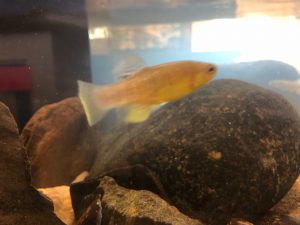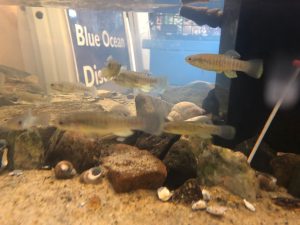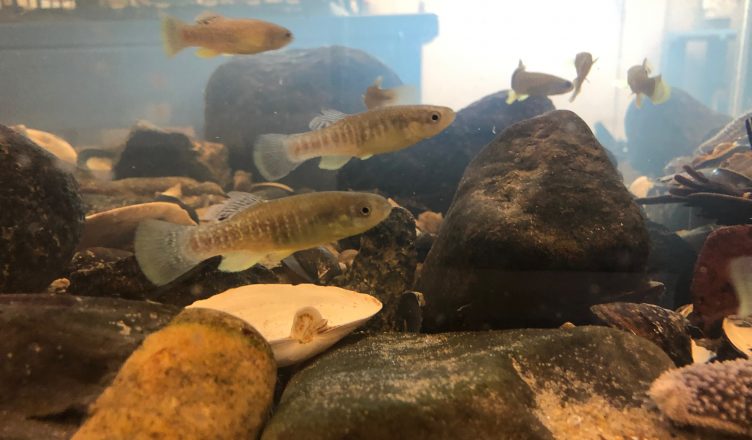This is part of our series about different animals and events at our Blue Ocean Discovery Center. This month we will discuss a Discovery Center inhabitant: the minnow or mummichog.
Visitors to the Blue Ocean Discovery Center often enjoy watching the many small schooling minnows as they swim in the observation tanks. The fish are also called mummichogs, which is a Native American name that refers to their ability to swim in groups.
What Does a Mummichog Look Like?

Minnows are olive brown or olive green fish that grow to be about three inches long. Some may have vertical bars on their sides and the males are usually darker in color. They can be found on the North American east coast from Canada to Florida in estuaries, salt marshes and along sheltered shorelines. We trap the minnows in the Hampton marsh at low tide but we often see them in the harbor and occasionally along the front beach.
Observe Only!
We keep the fish in the observation tanks rather than in the large touch tank in order to protect them from being touched by our visitors. Fish have a mucus coating on their scales which protects them from infection and parasites. This is why they feel slimy! When we touch a fish, we may disturb the protective coating and then the fish could become ill. This is important to remember if you have fish as pets at home. Don’t ever touch them and if they should jump out of their tank, you should wet your hand before picking them up. Catch and release fishermen should be careful in handling fish before releasing them as well.

Adaptations
Minnows are very tough fish. They can withstand a variety of environmental conditions including temperatures from 43-95 degrees F., salinities from brackish waters to three times the normal salinity of the ocean, and varying oxygen levels; even breathing air if necessary. With these abilities, it’s easy to see why they thrive in intertidal marshes where the temperature, salinity and oxygen levels can drastically change in a tide cycle. In the winter, they burrow deep into the mud and resurface in the spring.
What Do Mummichogs Eat?
Minnows are omnivores and eat plankton, small arthropods including mosquito larvae, fish eggs and marsh grass. In the Discovery Center, we feed them pieces of tilapia or other white fish and they thrive on it.
Minnows As Bait and for Research
Humans have used minnows as bait for centuries. Scientists are now using minnows in many studies including toxicology and evolutionary and developmental biology, The minnow was the first fish sent into space as part of the 1973 Skylab 3 mission.
We hope you will take time to watch the schooling minnows the next time you visit the Discovery Center. They are quite entertaining!
Learn More:
- A Whale of a Summer at the Blue Ocean Discovery Center
- Creature Feature: Hermit Crab
- Our Adopted Lobster
- More About the Blue Ocean Discovery Center






